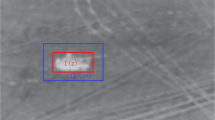Abstract
Target tracking is a popular but challenging problem in computer vision field. Due to many aggravating factors such as position transformation, illumination, occlusion, it is difficult to achieve robust target tracking. According to the above constraints, an improved target tracking algorithm based on spatio-temporal context (STC) under occlusions is proposed. On the basis of STC, the proposed method introduces a novel mechanism for dealing with occlusion, the scale update, and the learning rate update to reduce the error update of the model and restrain error accumulation. As a consequence, the tracking performance can be improved efficiently. Extensive experimental results show that our algorithm outperforms the original STC algorithm and some other state-of-the-art algorithms.





Similar content being viewed by others
References
Babenko, B., Yang, M. H., & Belongie, S. (2010). Visual tracking with online multiple instance learning. In IEEE conference on computer vision and pattern recognition. IEEE transactions on pattern analysis and machine intelligence, pp. 983–990.
Bolme, D. S., Beveridge, J. R., Draper, B. A., et al. (2010). Visual object tracking using adaptive correlation filters. In IEEE conference on computer vision and pattern recognition (CVPR), pp. 2544–2550.
Choi, J., Chang, H. J., Yun, S. et al. (2017). Attentional correlation filter network for adaptive visual tracking. In IEEE conference on computer vision and pattern recognition, IEEE.
Danelljan, M., Robinson, A., Khan, F. S., et al. (2016). Beyond correlation filters: Learning continuous convolution operators for visual tracking. In European conference on computer vision.
Evering, H., Gool, L., Williams, C., et al. (2010). The pascal visual object classes (VOC) challenge. International Journal of Computer Vision,88(2), 303–338.
Grabner, H., Matas, J., Gool, L. V., et al. (2010). Tracking the invisible: Learning where the object might be. In IEEE conference on computer vision and pattern recognition, CVPR 2010, San Francisco, CA, USA, 13–18 June, DBLP, pp. 1285–1292.
Gu, S., & Tomasi, C. (2011). Branch and track. In Computer vision and pattern recognition, IEEE Xplore, pp. 1169–1174.
Henriques, J. F., Caseiro, R., et al. (2012). Exploiting the circulant structure of tracking-by-detection with kernels. In Computer vision—ECCV 2012, Springer, Berlin, pp. 702–715.
Kiani Galoogahi, H., Fagg, A., & Lucey, S. (2017). Learning background-aware correlation filters for visual tracking. In IEEE international conference on computer vision (ICCV2017).
Li, X., Dick, A., Wang, H., et al. (2011). Graph mode-based contextual kernels for robust SVM tracking. IEEE International Conference on Computer Vision,2011, 1156–1163.
Lim, J., Ross, D. A., Lin, R. S., et al. (2004). Incremental learning for visual tracking. International Journal of Computer Vision,77(1–3), 125–141.
Liu, J., Wang, X., Li, T., et al. (2012). Spatio-temporal semantic features for human action recognition. Ksii Transactions on Internet & Information Systems,6(10), 2632–2649.
Mueller, M., Smith, N., & Ghanem, B. (2017). Context-aware correlation filter tracking. In 2017 IEEE conference on computer vision and pattern recognition (CVPR), IEEE Computer Society.
Nguyen, H. T., & Smeulders, A. (2004). Tracking aspects of the foreground against the background. In European conference on computer vision (pp. 446–456), Springer, Berlin.
Nourani-Vatani, N., Borges, P. V. K., & Roberts, J. M. (2012). A study of feature extraction algorithms for optical flow tracking. In Proceedings of the 2012 Australasian conference on robotics and automation, Victoria University of Wellington, New Zealand.
Quan, W., Jiang, Y., Zhang, J., et al. (2015). Robust object tracking with active context learning. Visual Computer,31(10), 1307–1318.
Wang, R., Dong, H., Han, T. X., et al. (2016). Robust tracking via monocular active vision for an intelligent teaching system. The Visual Computer,32(11), 1379–1394.
Wang, M., Liu, Y., & Huang, Z. (2017). Large margin object tracking with circulant feature maps. In 2017 IEEE conference on computer vision and pattern recognition (CVPR 2017), IEEE Computer Society.
Wang, N., Zhou, W., Tian, Q., Hong, R., Wang, M., & Li, H. (2018). Multi-cue correlation filters for robust visual tracking. In 2018 IEEE/CVF conference on computer vision and pattern recognition, pp. 4844–4853.
Wei, L., & Cheng, L. (2015). An online learning visual tracking method based on compressive sensing. Acta Optica Sinica,9, 176–183.
Wen, L., Cai, Z., Lei, Z., et al. (2014). Robust online learned spatio-temporal context model for visual tracking. IEEE Transactions on Image Processing,23(2), 785–796.
Yang, F. (2014). Robust visual tracking via multiple kernel boosting with affinity constraints. IEEE Transactions on Circuits and Systems for Video Technology,24(2), 242–254.
Yang, M., Wu, Y., & Hua, G. (2009). Context-aware visual tracking. IEEE Transactions on Pattern Analysis and Machine Intelligence,31(7), 1195–1209.
Yilmaz, A., Javed, O., & Shah, M. (2006). Object tracking: A survey. ACM Computing Surveys,38(4), 13.
Zhang, K., Zhang, L., Liu, Q., et al. (2014). Fast visual tracking via dense spatio-temporal context learning. In Computer vision–ECCV 2014, Springer, Berlin, pp. 127–141.
Zhang, K., Zhang, L., & Yang, M. H. (2012). Real-time compressive tracking. In European conference on computer vision, pp. 864–877.
Zhu, Z., Xu, G., Yang, B., et al. (2000). VISATRAM: A real-time vision system for automatic traffic monitoring. Image and Vision Computing,18(10), 781–794.
Acknowledgements
This research was supported by the National Natural Science Foundation of China (61573182).
Author information
Authors and Affiliations
Corresponding author
Ethics declarations
Conflict of interest
The authors declare that they have no conflict of interest.
Additional information
Publisher’s Note
Springer Nature remains neutral with regard to jurisdictional claims in published maps and institutional affiliations.
Rights and permissions
About this article
Cite this article
Yang, X., Zhu, S., Zhou, D. et al. An improved target tracking algorithm based on spatio-temporal context under occlusions. Multidim Syst Sign Process 31, 329–344 (2020). https://doi.org/10.1007/s11045-019-00664-5
Received:
Revised:
Accepted:
Published:
Issue Date:
DOI: https://doi.org/10.1007/s11045-019-00664-5




